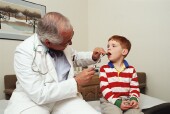
MONDAY, March 14 (HealthDay News) — Children who have a “medical home” — that is, a pediatrician or nurse they see regularly who offers comprehensive care — are more likely to have their medical and dental needs met, new research finds.
Yet it’s the sickest children — those who have a chronic condition or special need and require the most care — who are less likely to get the sort of care a medical home offers, the researchers said.
Children have a “medical home” if they have a usual source of care; a personal physician or nurse; are able to get referrals when needed; and receive help in coordinating health care needs, such as for a patient with chronic illness or special needs who sees multiple specialists, according to the American Academy of Pediatrics.
A medical home must also be “family centered,” meaning that the doctor is a good listener, spends enough time with the patient, is sensitive to family values, and makes an interpreter available when needed, said study lead author Bonnie Strickland, director of the U.S. Health Resources and Services Administration’s division of services for children with special health care needs.
“Parents had to answer ‘usually’ or ‘always’ to those questions,” Strickland said. “The medical home bar is set pretty high.”
About 57 percent of U.S. children ages 1 to 17 years received care in medical homes in 2007, according to the study that used data on nearly 84,000 children from the National Survey of Children’s Health.
Younger children were more likely to have a medical home than older children. There were racial and ethnic disparities as well: White children were the most likely to have a medical home, while Hispanic children were the least likely, followed closely by black children.
Mothers without a high school education were significantly less likely to report their children had a medical home, as were the poor, non-English speaking families and the uninsured.
About 61 percent of children whose parents said they were in excellent or very good health had a medical home, compared to 35 percent of kids in fair or poor health.
“This is especially concerning because children in poorer health need more from their medical home,” Strickland said.
Across the health-care spectrum, the federal government, private insurers and primary-care physicians are increasingly looking to medical homes as one solution to offer less expensive, but more comprehensive care for patients with chronic illnesses, Strickland said.
Children without a medical home were three to four times more likely to have an unmet medical or dental need, according to the study, published online March 14 in the journal Pediatrics.
Children who received care in medical homes were also more likely to have annual preventive medical visits, the study found.
Dr. Michael Barr is senior vice president in the division of medical practice, professionalism and quality for the American College of Physicians, which represents internists. He said that by putting the focus on preventive care and properly managing diseases, medical homes should help patients stay healthier and cost the health care system less over time.
“This study is another indication that well-organized, accessible health care that is patient- or family-centered really pays in terms of improving health care for children, not just those with special and chronic needs but pediatrics in general,” Barr said. “This is confirming this is a model that works.”
In the survey, nearly all children — 93 percent — had a usual source of care, and about the same number had a personal physician or nurse. About 82 percent of parents said they had few problems obtaining referrals, 69 percent said they received help with coordinating care when needed and 67 percent said they received family-centered care.
But only 57 percent of parents reported that the health care their children received met all of those criteria — the definition of a medical home.
“A lot of people think of the medical home as a source of primary care, or just a place to go when you need to see a doctor, but it’s far, far more than that,” Strickland said. “That’s why there is a high expectation that medical homes may be a very important factor in improving care in this country.”
More information
The American Academy of Pediatrics has more on medical homes.

